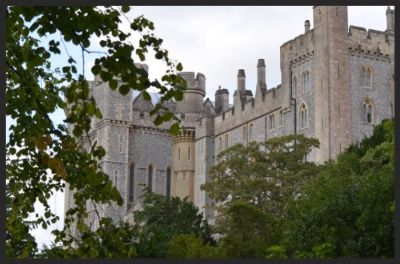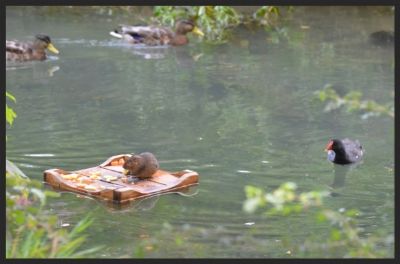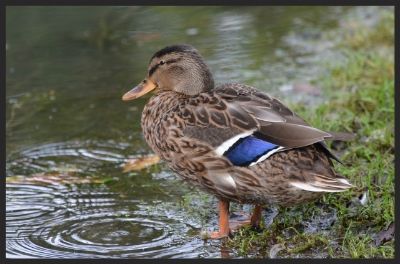A Date with Nature: RSPB Water Vole Event
This story happened on: 17/09/2014
Gallery
It was on a sunny day in August that I headed to the lovely Sussex market town of Arundel, a place full of history and heritage, where the impressive landmark of Arundel Castle overlooks the town.

Along a stream off of the River Arun, with the castle in the background, the RSPB set up their ‘date with nature’ event where members of the public can stop and watch the water voles in their natural habitat.
The water vole population sadly fell by 90% in the 1990s and are an endangered species of the UK and one of the creatures protected under the Wildlife and Countryside Act. Water voles are an important indicator of a healthy wetland environment and as such it is an absolute pleasure to see them flourish along the Sussex waterways in this area.

These sweet looking small mammals, often referred to as ‘Ratty’ due to the famous character in The Wind in the Willows (but in reality of no relation to rats), excavate widespread burrow systems into the banks of the waterways. These are generally found along streams, slow flowing rivers and other waterways.
I met with Mark Weston, event organiser at the RSPB, who, with the help of RSPB volunteers, has been on hand during the event to monitor the water voles along the banks of Mill Road stream in Arundel and answer questions from members of the public.
Mark has been a member of the RSPB since he was 8 years old. Before working for the RSPB he was a volunteer for 12 years. Mark explained that the biggest threats to the water vole population are the American mink and loss of habitat. Unlike other predators of the water vole, which there are many including herons and pikes, the minks can not only chase a water vole in the water, but follow it down into its burrow. As a result sadly reducing and often wiping out water voles in many of the UK’s rivers and streams.
The reintroduction schemes that have been taking place in many parts of the UK are providing a lifeline for the water voles. The water voles on the Mill Road stream are descendants of the water voles reintroduced by the Wildfowl and Wetlands Trust at Arundel Wetland Centre in 2005. These water voles have bred successfully and dispersed around the reserve and into the countryside beyond where they have been living and thriving ever since.
What you can expect to see
The RSPB feed the water voles carrots and apples on a floating platform and the water voles get quite protective of their food! The amount of energy they receive from this type of diet is much greater than the grasses and waterside vegetation that they normally eat along the banks of the waterways. The feeding platform allows for close viewing of the water voles in their natural habitat.
When the date with nature first launched in Arundel there was just one family of water voles, however, as the water vole has flourished in this area there are now 3 families living in this proximity, all who regularly appear for a treat!
There is also plenty of other wildlife along the waterways to spot, so keep your eyes open at all times!

Where to stay?
Littlehampton Caravan Club Site is just 3 miles from Arundel so it’s the ideal base for not only exploring Arundel but also the Sussex coast and South Downs. Littlehampton Caravan Club Site is set within 6.5 acres with 116 pitches available and a bus stop just 200 yards away.
When to go?
The date with nature water vole event took place during the last 2 weeks of August in 2014 but check on the RSPB website nearer the time to find out when it will be running next year and also to find out more information on other great events that take place across the whole of the UK all year round. You can of course walk along the paths that run alongside the River Arun and the waterways of Arundel and the surrounding area to see if you can spot the water voles at any time of year and I’m sure the RSPB will appreciate reports of sightings. Water voles do not hibernate, however, they are less active above ground during the winter months and as such it’s best to spot them from April to October.
What else is there to do in Arundel?
It’s also worth noting that Arundel has a festival that runs once a year in August. During this time there’s entertainment and shows taking place, including open air Shakespeare plays, performed at Arundel Castle. This often coincides with the RSPB’s water vole event. Other events take place throughout the whole year including historic walking tours, the Arundel ghost experience, farmers market and Christmas Fair. If you’re in the area it’s worth also visiting the Arundel Wetland Centre where you can take a boat safari or relax in the tranquil surroundings.
From Tuesdays to Sundays (tide dependent) The Belle sets sail between Arundel and Littlehampton, a great way to travel between the two towns.
There’s also lots to do and see in the seaside town of Littlehampton, including beach and seafront attractions, and lots of wonderful walks in the nearby area.
Great Days Out: Arundel Castle and Grounds
Arundel Castle was built at the end of the 11th century and commands magnificent views across the South Downs and the River Arun. It has been the family home to the Dukes of Norfolk and their ancestors for almost 1,000 years and is well worth a visit.
Don’t forget The Caravan Club’s Great Days Out offers, exclusive to members, which currently includes a £20 off a Gold Plus family ticket to Arundel Castle and Grounds.






brue
Motorhomer